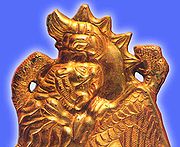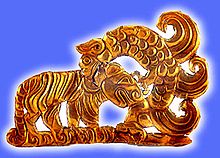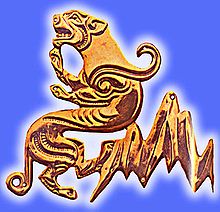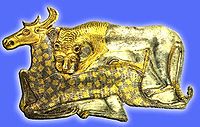
Persian-Sassanid art patterns
Encyclopedia

Patterns

Bulgars
The Bulgars were a semi-nomadic who flourished in the Pontic Steppe and the Volga basin in the 7th century.The Bulgars emerge after the collapse of the Hunnic Empire in the 5th century....
, Khazars
Khazars
The Khazars were semi-nomadic Turkic people who established one of the largest polities of medieval Eurasia, with the capital of Atil and territory comprising much of modern-day European Russia, western Kazakhstan, eastern Ukraine, Azerbaijan, large portions of the northern Caucasus , parts of...
, Sak-Scythian, and have recurred at different locations in Central Asia
Asia
Asia is the world's largest and most populous continent, located primarily in the eastern and northern hemispheres. It covers 8.7% of the Earth's total surface area and with approximately 3.879 billion people, it hosts 60% of the world's current human population...
. Hundred and eight years after the excavation of the Treasure of Nagyszentmiklós
Treasure of Nagyszentmiklós
The Treasure of Nagyszentmiklós or Treasure of Sânnicolau Mare is an important hoard of twenty-three early medieval gold vessels, in total weighing 9.945 kg, found in 1799 near the town then known as Nagy Szent Miklós or Groß-Sankt-Niklaus in northern Banat The Treasure of Nagyszentmiklós or...
' (1799) with a toreutics
Toreutics
Toreutics is a term, relatively rare in English, for artistic metalworking, by hammering gold or silver , engraving, Repoussé and chasing to form minute detailed reliefs or small engraved patterns. Toreutics can include metal-engraving - forward-pressure linear metal removal with a...
expo of 'griffin
Griffin
The griffin, griffon, or gryphon is a legendary creature with the body of a lion and the head and wings of an eagle...
fighting an elk
Elk
The Elk is the large deer, also called Cervus canadensis or wapiti, of North America and eastern Asia.Elk may also refer to:Other antlered mammals:...
' (see figure on the left) - another griffin
Griffin
The griffin, griffon, or gryphon is a legendary creature with the body of a lion and the head and wings of an eagle...
-&-elk
Elk
The Elk is the large deer, also called Cervus canadensis or wapiti, of North America and eastern Asia.Elk may also refer to:Other antlered mammals:...
motif has been discovered in the tombs of Hsiung-nu (early Huns
Huns
The Huns were a group of nomadic people who, appearing from east of the Volga River, migrated into Europe c. AD 370 and established the vast Hunnic Empire there. Since de Guignes linked them with the Xiongnu, who had been northern neighbours of China 300 years prior to the emergence of the Huns,...
, also Xiongnu
Xiongnu
The Xiongnu were ancient nomadic-based people that formed a state or confederation north of the agriculture-based empire of the Han Dynasty. Most of the information on the Xiongnu comes from Chinese sources...
) during Colonel Pyotr Kuzmich Kozlov expedition (1907–09) near Urga
Urga
Urga may refer to:* Ulan Bator, the capital of the republic of Mongolia* Ürgə, a municipality in Azerbaijan* Urga aka Close to Eden, a film by Nikita Mikhalkov, 1992...
(Outer Mongolia
Mongolia
Mongolia is a landlocked country in East and Central Asia. It is bordered by Russia to the north and China to the south, east and west. Although Mongolia does not share a border with Kazakhstan, its western-most point is only from Kazakhstan's eastern tip. Ulan Bator, the capital and largest...
).
A gold
Gold
Gold is a chemical element with the symbol Au and an atomic number of 79. Gold is a dense, soft, shiny, malleable and ductile metal. Pure gold has a bright yellow color and luster traditionally considered attractive, which it maintains without oxidizing in air or water. Chemically, gold is a...
symbolization of 'animals-in-fight' has been also found in the vicinity of the city of Turpan - the principle crossroad of the northern Silk Road
Silk Road
The Silk Road or Silk Route refers to a historical network of interlinking trade routes across the Afro-Eurasian landmass that connected East, South, and Western Asia with the Mediterranean and European world, as well as parts of North and East Africa...
(see the Turpan gold on your right). Gold
Gold
Gold is a chemical element with the symbol Au and an atomic number of 79. Gold is a dense, soft, shiny, malleable and ductile metal. Pure gold has a bright yellow color and luster traditionally considered attractive, which it maintains without oxidizing in air or water. Chemically, gold is a...
en 'animals-in-fight' has also been identified as 3rd – 2nd century B.C. Mongolia
Mongolia
Mongolia is a landlocked country in East and Central Asia. It is bordered by Russia to the north and China to the south, east and west. Although Mongolia does not share a border with Kazakhstan, its western-most point is only from Kazakhstan's eastern tip. Ulan Bator, the capital and largest...
(or southern Siberia
Siberia
Siberia is an extensive region constituting almost all of Northern Asia. Comprising the central and eastern portion of the Russian Federation, it was part of the Soviet Union from its beginning, as its predecessor states, the Tsardom of Russia and the Russian Empire, conquered it during the 16th...
), being charactteristic for Hsiung-nu or Xiongnu
Xiongnu
The Xiongnu were ancient nomadic-based people that formed a state or confederation north of the agriculture-based empire of the Han Dynasty. Most of the information on the Xiongnu comes from Chinese sources...
(see the scene of paired felines attacking ibexes as a cast of golden belt buckle on your left).
The Art of the Nomads

Asia
Asia is the world's largest and most populous continent, located primarily in the eastern and northern hemispheres. It covers 8.7% of the Earth's total surface area and with approximately 3.879 billion people, it hosts 60% of the world's current human population...
were a major force in history. Their power was not in the empires they built, but rather, it was the turmoil they have created on ancient civilizations such as China
China
Chinese civilization may refer to:* China for more general discussion of the country.* Chinese culture* Greater China, the transnational community of ethnic Chinese.* History of China* Sinosphere, the area historically affected by Chinese culture...
or Persia, affecting substantially their historical development. It is believed that the nomads ranged relentlessly and widely, forever moving on for sake of richer grazing for their horses and sheep. Migrations
Nomad
Nomadic people , commonly known as itinerants in modern-day contexts, are communities of people who move from one place to another, rather than settling permanently in one location. There are an estimated 30-40 million nomads in the world. Many cultures have traditionally been nomadic, but...
were often seasonal. In the course of such migrations nomads wove for themselves an imperishable and precious intimacy with their land and its natural resources. They could extract gold
Gold
Gold is a chemical element with the symbol Au and an atomic number of 79. Gold is a dense, soft, shiny, malleable and ductile metal. Pure gold has a bright yellow color and luster traditionally considered attractive, which it maintains without oxidizing in air or water. Chemically, gold is a...
with unprecedented ease. In summer, during the tribe's seasonal migration, a fleece
Wool
Wool is the textile fiber obtained from sheep and certain other animals, including cashmere from goats, mohair from goats, qiviut from muskoxen, vicuña, alpaca, camel from animals in the camel family, and angora from rabbits....
would be weighted on a riverbed to collect particles of alluvial gold
Gold
Gold is a chemical element with the symbol Au and an atomic number of 79. Gold is a dense, soft, shiny, malleable and ductile metal. Pure gold has a bright yellow color and luster traditionally considered attractive, which it maintains without oxidizing in air or water. Chemically, gold is a...
. Upon the tribes' return, the fleece
Wool
Wool is the textile fiber obtained from sheep and certain other animals, including cashmere from goats, mohair from goats, qiviut from muskoxen, vicuña, alpaca, camel from animals in the camel family, and angora from rabbits....
would be sheared, burned, and gold
Gold
Gold is a chemical element with the symbol Au and an atomic number of 79. Gold is a dense, soft, shiny, malleable and ductile metal. Pure gold has a bright yellow color and luster traditionally considered attractive, which it maintains without oxidizing in air or water. Chemically, gold is a...
ingot the size of a horse's hoof would result. The 'tay tayak' (the horse's hoof) was a unit of gold for a long period: a measure of golden metal rather than money, since gold was not fabricated as currency. Usage of gold was essentially spiritual - as emblems of priestly office, of prizes for physical prowess in ritual sport, or as adornment of the sacral ceremony of marriage.
Art Recursion

Phenomenon
A phenomenon , plural phenomena, is any observable occurrence. Phenomena are often, but not always, understood as 'appearances' or 'experiences'...
of art being recursive. Chomsky at al. argued that the core property of human communication (in a 'narrow' sense, including language) is recursion
Recursion
Recursion is the process of repeating items in a self-similar way. For instance, when the surfaces of two mirrors are exactly parallel with each other the nested images that occur are a form of infinite recursion. The term has a variety of meanings specific to a variety of disciplines ranging from...
. According to Chomsky at al. recursion
Recursion
Recursion is the process of repeating items in a self-similar way. For instance, when the surfaces of two mirrors are exactly parallel with each other the nested images that occur are a form of infinite recursion. The term has a variety of meanings specific to a variety of disciplines ranging from...
is attributed to limited syntax
Syntax
In linguistics, syntax is the study of the principles and rules for constructing phrases and sentences in natural languages....
in the conception - with a finite set of elements to yield a potentially infinite array of discrete expressions. Thomas explaines the art recursion (in a 'broad' sense) with imposion of archetypal structures existing beyond the faculty of human communication. Studying Persian-Sassanide art patterns and possibly their early Nomadic conceptions is uncovering their symbols (symbolism) and creative imagination.
See also
- Iranian artIranian artPersian arts, or Iranian arts is one of the richest art heritages in world history and encompasses many disciplines including architecture, painting, weaving, pottery, calligraphy, metalworking and stonemasonry.-The Persian rug:...
- History of decorative artsHistory of decorative artsThe Ancient World*Antique Furniture*Pottery of Ancient GreeceThe Byzantine EmpireThe Antique and Medieval Asian World*Chinese Pottery*Japanese Pottery*Korean PotteryThe Arts of Islam*Islamic pottery*Persian rug...
- ToreuticsToreuticsToreutics is a term, relatively rare in English, for artistic metalworking, by hammering gold or silver , engraving, Repoussé and chasing to form minute detailed reliefs or small engraved patterns. Toreutics can include metal-engraving - forward-pressure linear metal removal with a...
- Asian artAsian artAsian art can refer to art amongst many cultures in Asia.-Various types of Asian art:*Afghan art*Azerbaijanian art*Balinese art*Bhutanese art*Buddhist art*Burmese contemporary art*Chinese art*Eastern art*Indian art*Iranian art*Islamic art...
- Treasure of NagyszentmiklósTreasure of NagyszentmiklósThe Treasure of Nagyszentmiklós or Treasure of Sânnicolau Mare is an important hoard of twenty-three early medieval gold vessels, in total weighing 9.945 kg, found in 1799 near the town then known as Nagy Szent Miklós or Groß-Sankt-Niklaus in northern Banat The Treasure of Nagyszentmiklós or...
- Hunnic EmpireHunnic EmpireThe Hunnic Empire was an empire established by the Huns. The Huns were a confederation of Eurasian tribes from the steppes of Central Asia. Appearing from beyond the Volga River some years after the middle of the 4th century, they first overran the Alani, who occupied the plains between the Volga...
- XiongnuXiongnuThe Xiongnu were ancient nomadic-based people that formed a state or confederation north of the agriculture-based empire of the Han Dynasty. Most of the information on the Xiongnu comes from Chinese sources...
- Scythian artScythian artScythian art is art, primarily decorative objects, such as jewelry, produced by the nomadic tribes in the area known classically as Scythia, which was centred on the Pontic-Caspian steppe and ranged from modern Kazakhstan to the Baltic coast of modern Poland and to Georgia...
- Thraco-CimmerianThraco-CimmerianThraco-Cimmerian is a historiographical and archaeological term, composed of the names of the Thracians and the Cimmerians. It refers to 8th to 7th century BC cultures that are linked in Eastern Central Europe and in the area north of the Black Sea....
- Turko-Persian traditionTurko-Persian traditionThe composite Turko-Persian tradition was a variant of Islamic culture. It was Persianate in that it was centered on a lettered tradition of Iranian origin; it was Turkic insofar as it was for many generations patronized by rulers of Turkic background; it was Islamic in that Islamic notions of...

